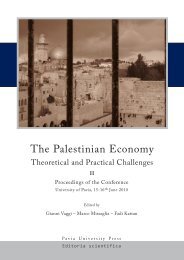Musica che affronta il silenzio - Scritti su Toru Takemitsu - Pavia ...
Musica che affronta il silenzio - Scritti su Toru Takemitsu - Pavia ...
Musica che affronta il silenzio - Scritti su Toru Takemitsu - Pavia ...
Create successful ePaper yourself
Turn your PDF publications into a flip-book with our unique Google optimized e-Paper software.
174<br />
Angela Ida De Benedictis<br />
– Japan in the sense of a nation – is that it is becoming increasingly nationalistic,<br />
and is starting not to listen to other opinions any more. (Nono 2001: 439) 33<br />
It is precisely in this allusion to ‘respect for differences’ that we can identify all the profundity<br />
and richness of Takemit<strong>su</strong>’s relationship with ‘other’ musical realities. That diversity which,<br />
as we said at the beginning, sparks off creative energies and is absorbed into his own musical<br />
horizon as the dialectic expression of different concepts of identity. Because it is in the core of<br />
the differences that the most profound bonds and identities of purpose are forged, for all the<br />
homologation and equality which – in the artistic sphere quite as much as in that of human<br />
relationships – we can perhaps hope remain purely utopian, coming to be seen as ‘undesirable<br />
effects’: ‘More and more, East and West are being evaluated on equal terms. But we’re not<br />
there yet: fundamental differences st<strong>il</strong>l remain’. (Takemit<strong>su</strong> 1989a: 199)<br />
Bibliography<br />
Bekku, Sadao (1961), ‘The Composer in Japan’, in Music – East and West, Executive<br />
Committee for 1961 Tokyo East-West Music Encounter, Tokyo: 91-98.<br />
Borio, Gianmario – Danuser, Hermann (hrsg. von) (1997), Im Zenit der Moderne: Die<br />
Internationale Ferienkurse für neue Musik Darmstadt 1946-1966, Rombach Verlag,<br />
Freiburg i.B., 4 voll.<br />
Burt, Peter (2001), The Music of Tru Takemit<strong>su</strong>, Cambridge University Press, Cambridge.<br />
De Benedictis, Angela I. – Rizzardi, Veniero (a c. di) (2000), Nuova musica alla radio:<br />
Esperienze allo Studio di Fonologia della RAI di M<strong>il</strong>ano 1954-1959, Cidim-RAI, Roma.<br />
Feldman, Morton (1985), ‘Darmstadt-Lecture’ [1984], in Essays, Beginner Press, Köln:<br />
181-213.<br />
Galliano, Luciana (2002), ‘The Roaring Epoch: Works of the 1950s-1960s’, in A Way a<br />
Lone: Writings on Tru Takemit<strong>su</strong>, ed. by de Ferranti, Hugh – Narazaki, Yoko,<br />
Academia Music, Tokyo: 20-41.<br />
Hirashima, Masao (1961), ‘The Composer in Japan Today’, in Music – East and West,<br />
Executive Committee for 1961 Tokyo East-West Music Encounter, Tokyo: 99-106.<br />
Konuma, Jun-ichi (1999), Takemit<strong>su</strong> Tru: Oto, Kotoba, Imji [Suono, parola, immagine],<br />
Seid-sha, Tokyo.<br />
33 On the is<strong>su</strong>e of nationalism, which meant a lot to Takemit<strong>su</strong>, cf. also Contemporary Music in Japan (1989a:<br />
198). Also in the conversation with Luigi Nono (2001: 439), Takemit<strong>su</strong> delivered a significant warning: ‘I am<br />
sincerely convinced of this: Japan, of which we are citizens, seems to be going in a direction which is straying<br />
too far off course, and we artists have the duty to say: “Hang on a moment!”’.

















